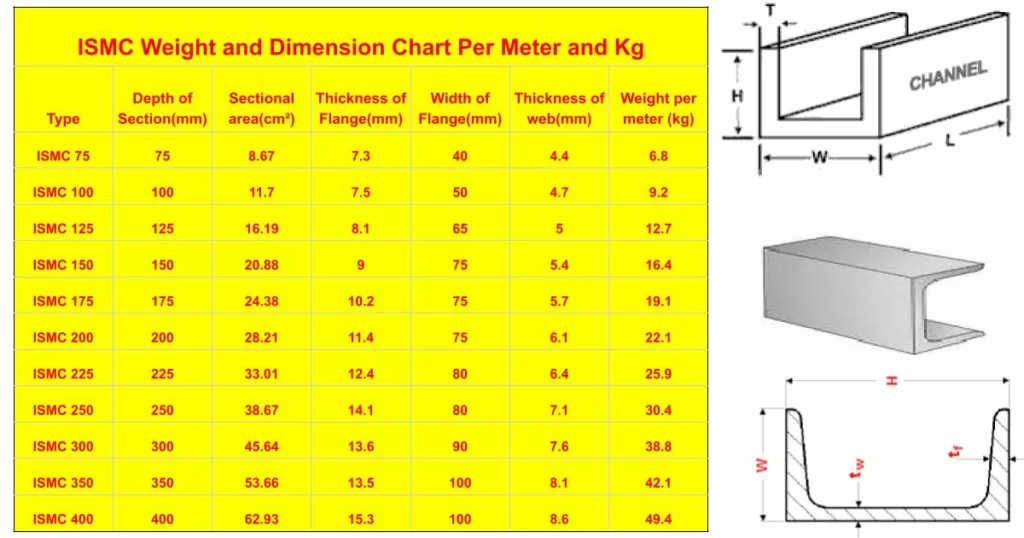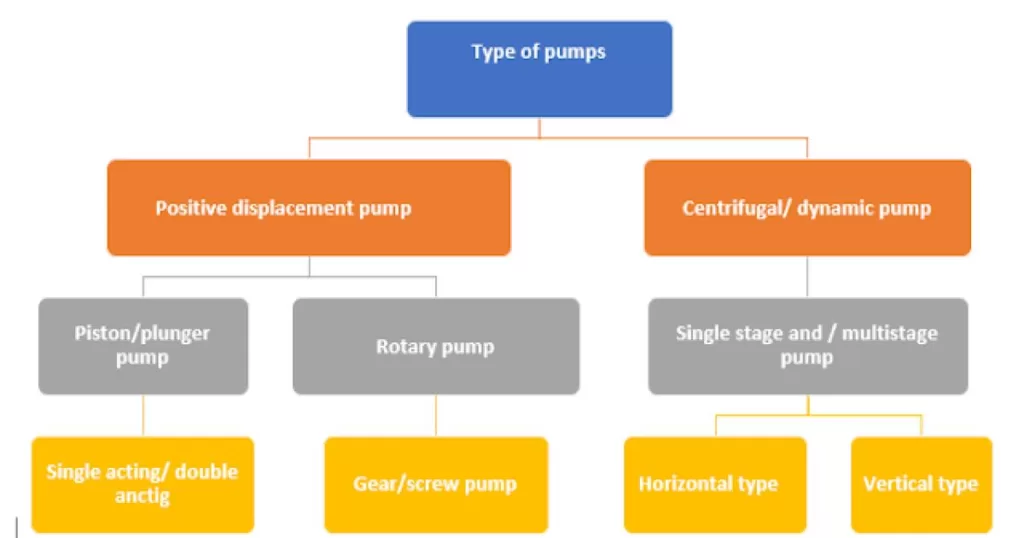Understanding ISMC Channels
Before we dive into the weight and dimension chart, let’s briefly understand what ISMC channels are. ISMC channels are hot-rolled steel channels commonly used in structural applications. They have a distinctive “C” shape and are characterized by their dimensions and weight. These channels are designed to provide structural strength and support for a wide range of applications, including building frames, bridges, and industrial structures.
Full Form: The full form of ISMC is Indian Standard Medium Weight Channel.
ISMC Weight and Dimension Chart
The ISMC weight and dimension chart provides valuable information about the various sizes and weights available for ISMC channels. The chart typically includes the following parameters:
- Sectional Weight: This refers to the weight of the ISMC channel per unit length. It is measured in kilograms per meter (kg/m) or pounds per foot (lbs/ft).
- Depth: The depth of an ISMC channel is the vertical distance between the top and bottom flanges. It is measured in millimeters (mm) or inches (in).
- Width: The width of an ISMC channel is the horizontal distance between the outer edges of the flanges. It is also measured in millimeters (mm) or inches (in).
- Web Thickness: The web thickness is the thickness of the vertical center section (web) of the ISMC channel. It is measured in millimeters (mm) or inches (in).
- Flange Thickness: The flange thickness is the thickness of the horizontal top and bottom sections (flanges) of the ISMC channel. It is measured in millimeters (mm) or inches (in).
| ISMC Weight Chart Per Meter and Kg | ||||||
| Type | Depth of Section(mm) | Sectional area(cm²) | Thickness of Flange(mm) | Width of Flange(mm) | Thickness of web(mm) | Weight per meter (kg) |
| ISMC 75 | 75 | 8.67 | 7.3 | 40 | 4.4 | 6.8 |
| ISMC 100 | 100 | 11.7 | 7.5 | 50 | 4.7 | 9.2 |
| ISMC 125 | 125 | 16.19 | 8.1 | 65 | 5 | 12.7 |
| ISMC 150 | 150 | 20.88 | 9 | 75 | 5.4 | 16.4 |
| ISMC 175 | 175 | 24.38 | 10.2 | 75 | 5.7 | 19.1 |
| ISMC 200 | 200 | 28.21 | 11.4 | 75 | 6.1 | 22.1 |
| ISMC 225 | 225 | 33.01 | 12.4 | 80 | 6.4 | 25.9 |
| ISMC 250 | 250 | 38.67 | 14.1 | 80 | 7.1 | 30.4 |
| ISMC 300 | 300 | 45.64 | 13.6 | 90 | 7.6 | 38.8 |
| ISMC 350 | 350 | 53.66 | 13.5 | 100 | 8.1 | 42.1 |
| ISMC 400 | 400 | 62.93 | 15.3 | 100 | 8.6 | 49.4 |
Importance of the ISMC Weight and Dimension Chart
The ISMC weight and dimension chart is a valuable resource for engineers, architects, and construction professionals. Here’s why it is essential:
- Structural Design: The chart allows structural designers to select the appropriate ISMC channel based on the required load-bearing capacity and dimensions of the structure. It helps ensure the safety and stability of the project.
- Material Calculation: The sectional weight information provided in the chart enables accurate material calculations for estimating the overall weight of the structure. This is crucial for transportation, handling, and cost estimation purposes.
- Standardization: The ISMC weight and dimension chart follows the Indian Standard (IS) specifications, ensuring uniformity and standardization in the construction industry. It provides a reference for choosing the right channel based on project requirements.
- Compatibility: By referring to the chart, engineers can identify compatible ISMC channels for connecting different structural elements. This ensures that the channels can be joined seamlessly and efficiently.
How to Use the ISMC Weight and Dimension Chart
To use the ISMC weight and dimension chart effectively, follow these steps:
- Determine the load and structural requirements for your project.
- Identify the depth, width, web thickness, and flange thickness based on your design specifications.
- Refer to the ISMC weight and dimension chart to find the corresponding ISMC channel size that matches your requirements.
- Note the sectional weight of the selected ISMC channel for further calculations.
- Verify the availability of the chosen ISMC channel size with suppliers or manufacturers.
- Make any necessary adjustments.
Formula and Calculation for ISMC Channels:
The weight of an ISMC channel can be calculated using the following formula:
Weight (kg/m) = (A – B) * C * D
Where: A = Width of the flange (mm) B = Thickness of the flange (mm) C = Width of the web (mm) D = Thickness of the web (mm)
Let’s take an example to demonstrate the calculation:
Example:
Consider an ISMC channel of size ISMC 200 with the following dimensions: Width of the flange (A) = 75 mm Thickness of the flange (B) = 9.0 mm Width of the web (C) = 200 mm Thickness of the web (D) = 6.2 mm
Using the formula, we can calculate the weight of the ISMC channel:
Weight (kg/m) = (A – B) * C * D Weight (kg/m) = (75 – 9.0) * 200 * 6.2 Weight (kg/m) = 66 * 200 * 6.2 Weight (kg/m) = 81840 kg/m
Therefore, the weight of an ISMC 200 channel with the given dimensions is 81840 kg/m.
It’s important to note that the above calculation gives the weight per meter of the ISMC channel. If you need to calculate the total weight for a specific length, you can multiply the weight per meter by the length in meters.
SMC Weight Chart
Below is a list of common ISMC channel sizes along with their respective weights per meter (kg/m):
- ISMC 75 – Weight: 5.67 kg/m
- ISMC 100 – Weight: 8.90 kg/m
- ISMC 125 – Weight: 11.70 kg/m
- ISMC 150 – Weight: 14.90 kg/m
- ISMC 200 – Weight: 22.40 kg/m
- ISMC 250 – Weight: 34.60 kg/m
- ISMC 300 – Weight: 42.20 kg/m
- ISMC 400 – Weight: 65.40 kg/m
- ISMC 450 – Weight: 77.60 kg/m
- ISMC 500 – Weight: 92.40 kg/m
CODE AND STANDARD FOR ISMC
The ISMC (Indian Standard Medium Weight Channel) follows the standards and codes set by the Bureau of Indian Standards (BIS). The relevant code for ISMC channels is IS 808:1989, which specifies the dimensions, weight, and technical requirements for structural steel sections, including ISMC channels.
IS 808:1989 – Indian Standard for Rolled Steel Channels (ISMC)
This standard provides guidelines for the manufacturing and usage of rolled steel channels, including ISMC channels. It covers various dimensions, weight, tolerances, and mechanical properties of ISMC channels. The code ensures uniformity, quality, and safety in the construction industry in India.
Some key aspects covered in IS 808:1989 for ISMC channels include:
- Dimensional Specifications: The standard specifies the depth, width, web thickness, and flange thickness of ISMC channels. It provides a range of sizes to suit different structural requirements.
- Weight Specifications: IS 808:1989 provides the weight per meter for each size of ISMC channel. These weight specifications are crucial for load calculations, material estimation, and transportation considerations.
- Tolerance Requirements: The code defines the permissible variations in dimensions and weight for ISMC channels. It ensures that the manufactured channels meet the required specifications and maintain dimensional accuracy.
- Mechanical Properties: IS 808:1989 specifies the mechanical properties, including yield strength, tensile strength, and elongation, for ISMC channels. These properties determine the structural strength and performance of the channels.
- Designation: The standard provides a specific designation system for ISMC channels, ensuring clear identification and communication of the channel size and properties.
- Testing and Quality Control: IS 808:1989 outlines the testing procedures and quality control measures to ensure that the manufactured ISMC channels meet the required standards and specifications.
Compliance with IS 808:1989 is essential for manufacturers, suppliers, engineers, and architects involved in the design and construction of structures that incorporate ISMC channels. It ensures that the channels used in construction projects meet the necessary quality and safety standards.




